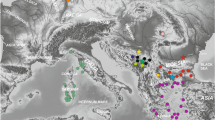Abstract
Marker elements were estimated from the red cosmetics collected from different ancient burials and mine ruins in three separate districts of Japan. Element levels were displayed in reference to the relative amount to sulfur (RA/S), by which the cosmetics were divided into five types: I—a low Hg/S with a low Fe/S; II—both moderate Hg/S and Fe/S; III—a moderate Hg/S with a high Fe/S; III 2—a high Hg/S with a moderate Fe/S; IV—a high Hg/S with a high Fe/S. The cosmetics can be further characterized by referring to other contaminants such as Zn, Cu, and Mn. These combined analyses with contaminant metals were capable of characterizing the origins of the cosmetics; it is useful to compare them to each other. The cosmetics were identified as being due to several groups of contaminants from ancient mines in Japan, and also with this system analysis of the markers it is possible to identify them from neighboring countries.
Similar content being viewed by others
References
M.-o. Yamada, T. Minami, G. Yamada, Y. Tohno, S. Tohno, Y. Ikeda, et al., Different element ratios of red cosmetics excavated from ancient burials of Japan, Sci. Total Environ. 199, 293–298 (1997).
M.-o. Yamada, T. Minami, M. Ichii, Y. Okazaki, M. Utsumi, S. Tohno, et al., An improved method for estimating original mineral contents in excavated bone using sulfur, Biol. Trace Element Res. 52, 155–161 (1996).
M.-o. Yamada, S. Tohno, Y. Tohno, T. Minami, M. Ichii, and Y. Okazaki, Accumulation of mercury in excavated bones of two natives in Japan, Sci. Total Environ. 162, 253–256 (1995).
J. B. Lambert, C. B. Szpunar, and J. E. Buikstra, Chemical analysis of excavated human bone from middle and late Woodland sites, Archaeometry 21, 115–129 (1979).
Z. Jaworowski, F. Barbalat, and C. Blain, Heavy metals in human and animal bones from ancient and contemporary France, Sci. Total Environ. 43, 103–126 (1986).
H. Kosugi, K. Hanihara, T. Suzuki, T. Kawabe, S. Himeno, and M. Morita, Elemental composition of ancient Japanese bones, Sci. Total Environ. 51, 93–107 (1986).
T. Shinomiya, K. Shinomiya, C. Orimoto, T. Minami, Y. Tohno, and M.-o. Yamada, In- and out-flows of elements in bones embedded in reference soils, Forensic Sci. Int. 98, 109–118 (1998).
Author information
Authors and Affiliations
Rights and permissions
About this article
Cite this article
Yamada, Mo., Okayama, M., Chikamori, K. et al. Possible contaminant origins of the red cosmetics decorating ancient burial sites in Japan. Biol Trace Elem Res 77, 149–158 (2000). https://doi.org/10.1385/BTER:77:2:149
Received:
Accepted:
Issue Date:
DOI: https://doi.org/10.1385/BTER:77:2:149



